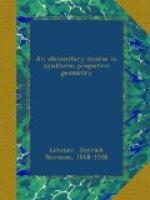171. Lack of appreciation of Desargues. Desargues’s methods, entirely different from the analytic methods just then being developed by Descartes and Fermat, seem to have been little understood. “Between you and me,” wrote Descartes(10) to Mersenne, “I can hardly form an idea of what he may have written concerning conics.” Desargues seems to have boasted that he owed nothing to any man, and that all his results had come from his own mind. His favorite pupil, De la Hire, did not realize the extraordinary simplicity and generality of his work. It is a remarkable fact that the only one of all his associates to understand and appreciate the methods of Desargues should be a lad of sixteen years!
172. Pascal and his theorem. One does not have to believe all the marvelous stories of Pascal’s admiring sisters to credit him with wonderful precocity. We have the fact that in 1640, when he was sixteen years old, he published a little placard, or poster, entitled “Essay pour les conique,"(11) in which his great theorem appears for the first time. His manner of putting it may be a little puzzling to one who has only seen it in the form given in this book, and it may be worth while for the student to compare the two methods of stating it. It is given as follows: "If in the plane of _M__, __S__, __Q__ we draw through __M__ the two lines __MK__ and __MV__, and through the point __S__ the two lines __SK__ and __SV__, and let __K__ be the intersection of __MK__ and __SK__; __V__ the intersection of __MV__ and __SV__; __A__ the intersection of __MA__ and __SA__ (__A__ is the intersection of __SV__ and __MK__), and __{~GREEK SMALL LETTER MU~}__ the intersection of __MV__ and __SK__; and if through two of the four points __A__, __K__, __{~GREEK SMALL LETTER MU~}__, __V__, which are not in the same straight line with __M__ and __S__, such as __K__ and __V__, we pass the circumference of a circle cutting the lines __MV__, __MP__, __SV__, __SK__ in the points __O__, __P__, __Q__, __N__; I say that the lines __MS__, __NO__, __PQ__ are of the same order."_ (By “lines of the same order” Pascal means lines which meet in the same point or are parallel.) By projecting the figure thus described upon another plane he is able to state his theorem for the case where the circle is replaced by any conic section.
173. It must be understood that the “Essay” was only a resume of a more extended treatise on conics which, owing partly to Pascal’s extreme youth, partly to the difficulty of publishing scientific works in those days, and also to his later morbid interest in religious matters, was never published. Leibniz(12) examined a copy of the complete work, and has reported that the great theorem on the mystic hexagram was made the basis of the whole theory, and that Pascal had deduced some four hundred corollaries from it. This would indicate that here was a man able to take the unconnected materials of projective geometry and shape them into some such symmetrical edifice as we have to-day. Unfortunately for science, Pascal’s early death prevented the further development of the subject at his hands.




